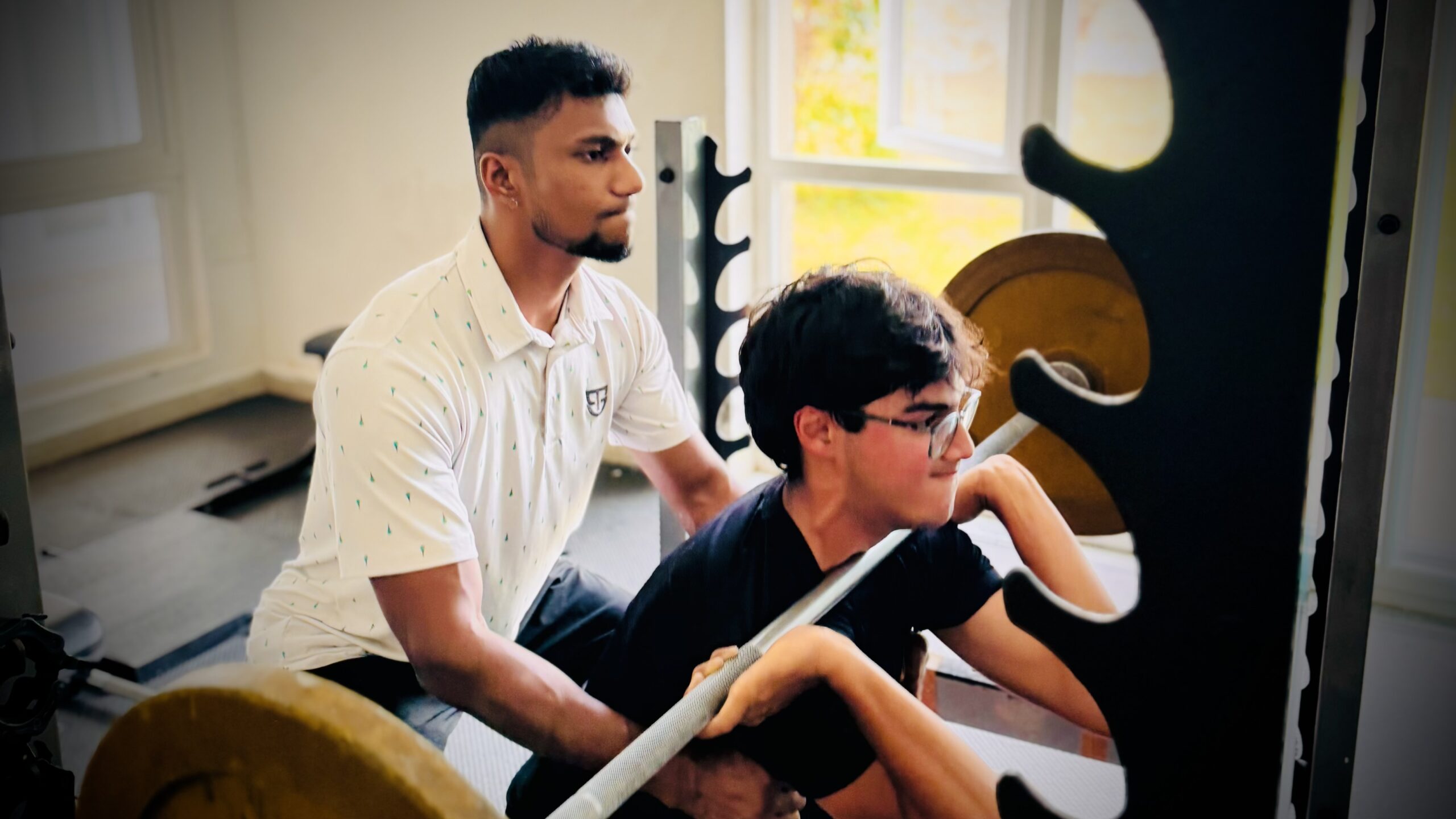The words “hypertrophy” and “strength” are frequently used in any rigorous training setting. Although both are components of resistance training and can cause increased muscle mass and enhanced performance, their functions and methods differ somewhat. Strength and Conditioning Coach Bharani recently hosted player meeting where he addressed the golfers on the differences between strength and hypertrophy training and how both are essential for a well-rounded fitness program for anyone pursuing sports.
Understanding Hypertrophy
The primary goal of hypertrophy is to increase muscle size. The three main factors responsible for this include muscle injury, metabolic stress, and mechanical tension.
The stress that muscles experience when subjected to a load for an extended period, often referred to as time under tension, is known as mechanical tension. This is frequently observed during deliberate, slow motions involving prolonged muscle activation. A slow-paced bicep curl, for instance, puts additional strain on the muscle and encourages growth.
Moving ahead in the discussion, he talked about the burning sensation one experiences during higher-rep sets, also known as metabolic stress, is caused by lactate accumulation in your muscles. The body receives the “pump” or swelling as a signal to produce additional muscle cells, allowing it to adjust to the increased metabolic demand.
Lastly, the development of micro-tears during exercise, especially during eccentric movements (the lowering phase of a lift), is one way that muscle damage leads to hypertrophy. Over time, the body thickens the muscle fibers by repairing these microscopic tears.
As the discussion went deeper, there was discussion on moderate weight and greater repetitions—usually 8 to 15 per set—which are the main goals of hypertrophy training. The goal is to maintain muscle tension over several repetitions and sets, with brief rest intervals of 30 to 90 seconds, rather than lifting the heaviest weights possible. This keeps the muscles under tension, encouraging muscle growth and development.
Understanding Strength training
On the other hand, the goal of strength training, is to increase one’s weightlifting capacity. Here, your ability to generate the most force is more important than muscle size. Short, explosive efforts are used here instead of long-term strain.
Coach Bharani also shed some light on how the primary job of strength training is neural adaptations. For your muscles to contract with greater force, you must train your central nervous system to fire more quickly and activate more motor units. This explains why after an intense strength session athletes frequently experience mental exhaustion —neurological demand takes a toll in addition to physical fatigue.
Athletes lift greater weights (generally 85–100 percent of their one-rep maximum) for fewer repetitions (usually 1–5 each set) to build strength. Rest intervals are substantially longer—anywhere from three to five minutes—because the emphasis is on lifting with maximum exertion. This allows the body’s ATP-PC energy system and neurological system to recuperate fully.
The use of fast-twitch muscle fibers is a crucial aspect of strength training. These fibers help in lifting significant objects because they produce strong force bursts. Both slow-twitch and fast-twitch fibers are recruited through hypertrophy; however, owing to the lift’s intensity, strength training primarily utilizes the fast-twitch fibers only.
Training Structure and Rest Periods
The structure of the two training philosophies lead to significant differences. Workouts for hypertrophy involves use of lighter to moderate weights but contain a larger training volume (more sets and reps). Rest periods are purposefully kept brief because the goal is to maintain the muscles under stress for as long as feasible.
Strength training programs, on the other hand, are based on higher intensity but lower training volume. In this you perform fewer repetitions and frequently fewer complete sets while lifting larger weights. The body’s energy systems, especially the creatine phosphate system, which takes three to five minutes to recover fully, depend on the extended rest intervals in between sets.
According to Coach Bharani, creatine supplements are frequently taken to enhance muscle growth during off-season or hypertrophy phases and to support brief bursts of high-intensity performance during strength phases.
Understanding Muscle Fiber Activation
There exist two main kinds of muscle fibers in our bodies: slow-twitch and fast-twitch. Slow-twitch fibers are more active during hypertrophy training because they are more resilient to fatigue and are better suited for endurance exercises or longer-duration sets. Conversely, fast-twitch fibers are mainly used during strength training and are made for rapid, explosive efforts.
It’s interesting to note that hypertrophy exercises engage both types of fibers, particularly when performed with longer sets and a regulated speed. Strength training nearly exclusively focuses on recruiting fast-twitch fibers, as it requires explosive strength.
Coach Bharani mentioned that the choice of exercises and tempo is modified based on the training phase. For instance, strength training requires quicker and more explosive lifts with heavier weights, while hypertrophy on the other hand, encourages slower movements with lighter weights.
Monitoring Development: Performance vs. Appearance
Increases in muscle size, changes in body composition, and the ability to track metrics such as muscle girth and waist-to-hip ratio over time make progress in hypertrophy exercises apparent. You might observe that your muscles appear fuller or have more definition.
On the other hand, performance is a better indicator of strength gains. A higher one-rep maximum, more substantial vertical jumps, or a quicker clean or squat execution all point to increased force production and improved brain efficiency. Although these physical alterations may not always be apparent, performance athletes need to make these adjustments, particularly when competing.
The Intersection between Hypertrophy and Strength
It’s crucial to note that while hypertrophy and strength training have different focuses, they are not mutually exclusive. In reality, regardless of the approach they start with, the majority of athletes – especially novices – will experience an increase in both muscle size and strength. However, as you get more proficient, training needs to be more specific.
Being in the correct zone at the right moment is essential for peak training, Coach Bharani stressed. For instance, to enhance performance during competition preparation, athletes focus solely on strength training with few repetitions and high intensity. To grow muscle mass and address imbalances, the emphasis may shift to hypertrophy during the off-season. Regardless of whether the workout is primarily focused on strength or size, new trainees can benefit from both simultaneously and will see results.
Progressive Overload: The Foundation of Both
This refers to the progressively increasing volume over time in hypertrophy, achieved by adding slightly more weight, or increasing the number of sets, or even increasing the number of repetitions. The goal is to force the muscle to adjust to an increasing demand.
Progressive overload in strength training refers to progressively raising the load while maintaining low repetition counts. The difficulty lies in doing greater work rather than more. Lifting 120 kg for two repetitions one week and 125 kg for two repetitions the next could be an example of this.
Know Your Training Goal
Knowing what stage of training you’re at and why was the most important lesson learned from the session. The goal of hypertrophy training is to induce muscular injury, metabolic stress, and mechanical tension to increase muscle size. To increase time under tension, you must train with moderate weights, perform more repetitions, and rest less.
Increasing your force production speed becomes the primary goal of strength training. In addition to lifting more weight and taking longer breaks, you will also teach your nervous system to react more forcefully and quickly.
By knowing the science underlying both strategies, you’ll be in a better position to stick to your program, maintain your motivation, and observe actual, quantifiable progress, whether it be in strength, size, or both.
TSG coaches are technically sound and passionate about the respective fields. We hope the blog helped your learning.



